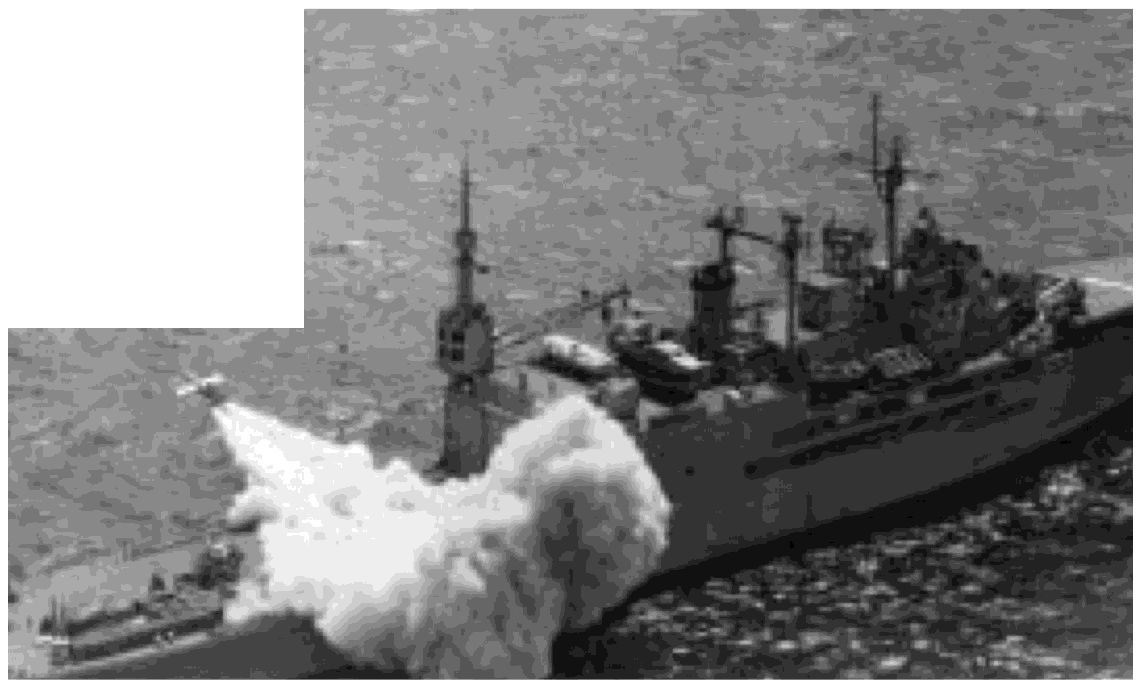
174
UNITED STATES NAVAL AVIATION
1910-1995
1948-Contin ued
plified. Carrier Air Groups became CVG without
regard to their carrier assignment; carrier squadrons
VF and VA were assigned two or three digit numbers,
the first of which was the same as the parent air
group, and suffix letters were dropped. Patrol
squadrons reverted to the simple VP designation.
Special designations for transport squadrons, as VRF
and VRU, became VR. Some VC squadrons became
VAW to reflect their air warning mission, while others
became VFN or VAN to reflect all-weather capability.
5 September
The JRM-2 Caroline Mars of VR-2, on
a 390-mile flight from Patuxent River, Md., to
Cleveland, Ohio, carried a 68,282-pound cargo, the
heaviest payload ever lifted in an aircraft.
1
October
Modification of the seaplane tender
Norton Sound
was completed at the Philadelphia
Naval Shipyard, and after a brief shakedown she was
placed in operation as the Navy's first guided missile
experimental and test ship.
27 October
Operation Vittles-VR-6 and -8 of the
Military Air Transport Service, were ordered to move
from their Pacific bases to Germany to take part in the
Berlin Airlift.
1
November
The Naval Air Advanced Training
Command was transferred from NAS Jacksonville, Fla.,
to NAS Corpus Christi, Tex., in accordance with plans
to convert the Jacksonville area into a fleet aviation
center.
5 November
To meet the requirements of landing
aircraft weighing up to 50,000 pounds at speeds as
high as 105 knots, a project was initiated at the Naval
Aircraft Factory for design of Mark 7 high energy
absorption arresting gear.
9 November
Navy transport squadrons, transferred
from the Pacific to assist in Operation Vittles, began
flying cargo into Berlin.
17 December
To meet the mounting requirements
for transatlantic airlift in support of Operation Vittles,
VR-3 was switched from flying the domestic routes to
the Westover, Mass., to Frankfurt, Germany, run.
1949
23
January
Palau
completed a 12-day test period off
the New England coast developing the capability of
carriers to conduct air operations under cold and
severe weather conditions. This marked the Navy's
continued interest in cold weather tests, first demon-
strated on the
Langley
in the same area 18 years
before.
26 January
Norton Sound,
the nation's first guided-
missile experimental test ship, launched its first mis-
sile, the Loon, off the Naval Air Missile Test Center,
Point Mugu, Calif.
. .
Norton Sound, converted from a seaplane tender to the Navy's first
guided missile ship, fires a Loon 415146
27 January
The Chief of Naval Operations autho-
rized conversion of all new-construction cruisers to
accommodate helicopters.
3 February
The Lockheed R60 Constitution, com-
missioned the day before at NAS Alameda, Calif., inau-
gurated her transcontinental service, from Moffett Field,
Calif., to Washington, D.C., by establishing a new
record for personnel carried on a transcontinental
flight. With 78 passengers and 18 crewmen, the 92-ton
plane crossed the continent in 9 hours and 35 minutes.
25 February
The Caroline Mars, a JRM-2 flying boat,
broke the world record for passenger lift by transport-
ing 202 men from NAS Alameda to San Diego, Calif.,
and broke it again the same day on the return flight
with a load of 218 men. These loads were in addition
to a four-man crew.
4
March
The Caroline Mars, a JRM-2 flying boat of
Transport Squadron 2, set a new record for persons
carried aloft by transporting 263 passengers and a
crew of six on a Fleet Logistic Air Wings flight from
San Diego, Calif. to Alameda, Calif. The flight was of 2
hours 41 minutes duration and the passengers were
the officers and men of Air Group 15 on a routine
transfer of station.
 |
16 |
 |